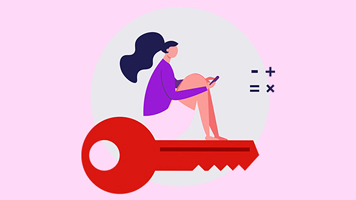When it comes to deciding what sort of home loan to choose for your first home or next home, there are multiple options and factors to consider.
Should you opt to lock in a fixed rate home loan to give you certainty on repayments or to take advantage of a great interest rate? But then are you missing out on the flexibility of a variable rate home loan that can be adapted to suit your financial situation and which will change with the market in the future?
There is also a third option that could allow you to take advantage of the features of both: you can split your home loan balance into two separate accounts – one with a fixed interest rate and one with a variable interest rate.
With a Westpac Fixed Options home loan, for example, you can fix your interest rate for a loan term of 1 to 5 years.
You could choose to take advantage of a low interest rate being offered, locking it down for the agreed term. But it’s important to remember that you can’t see the future – there is a chance the market may change, and your fixed rate could end up being higher than variable rates available in market.
Fixed rates are also less flexible and often have limits on making additional repayments to your home loan, meaning you may not be able to get as far ahead on your loan should you happen to have spare cash to put towards it. They also have fewer features, such as no offset account, and can incur a break cost fee should you repay your loan early, switch your product or change your interest rate during the fixed rate period.
What is a variable rate home loan?
If it's flexibility you’re after, it’s flexibility you’ll get with a variable rate home loan. This loan option typically comes with a range of features which allow you to adapt based on changes in your life or financial circumstances.
For example, if you find yourself with some extra money you’d like to put towards your mortgage, you can generally make unlimited extra repayments, which balances against your home loan amount, resulting in lower interest charges (our repayment calculator shows how this could work). And if you need access to that cash at a later date, you might choose to have a redraw facility , where you can redraw additional funds (which is also possible with extra repayments made on fixed rate loans).
Variable rate loans can also have features such as an offset account, which is a transaction account linked to your home loan that can help you pay off your mortgage sooner. In a nutshell, keeping savings or spare cash in an offset account will reduce the loan balance on which you pay interest, meaning you pay less interest and more off your loan principal every month.
But when it comes to variable rate loans, it’s important to be aware that your interest rate will likely change over time. This can work both ways - you could reap the benefits of rate decreases in a low-interest rate environment, but you could also find your rate increases, which would involve paying more on your regular loan repayment each month. So it’s worth considering how you would manage repayments if this was to happen by using our interest rate change calculator.
What is a split loan?
A split loan is when you divide your home loan balance into two loan accounts - meaning you can nominate a portion of the loan to have a fixed interest rate and the remainder could have a variable interest rate.
While there are pros and cons to both fixed rate and variable rate home loans, a split loan allows you to hedge your bets and tailor your home loan in a way that works best for you and your financial goals.
Whether you want to get ahead on your variable rate loan with no cap on extra repayments, or are interested in the security of a fixed rate loan, split loans allow you to create the right home loan to suit your needs.
How does a split loan work?
Keep in mind that a split loan isn’t a separate loan by itself. It involves splitting your home loan balance into two separate accounts – one with a fixed rate and one with a variable rate – and you typically make separate repayments on each.
If you’re applying for a new home loan with Westpac, you can do this online and one of our home lending specialists will call you to talk you through the process. For an existing home loan, you might choose to fix part of all of your variable rate loan balance via Westpac Live online banking.
What percentage of the loan is fixed and variable is completely up to you! For example, you may choose a 60:40 split on your $500,000 home loan. Your home loan would then be divided into two separate loans with a fixed interest rate charged on $300,000 and a variable interest rate on the remaining $200,000. If you find your variable rate is going to rise, you can always fix that rate too to lock in certainty. Similarly, if you find you want to switch your fixed rate to variable at the end of its loan term, you can. You can also switch before the end of the fixed rate term if you need to, but keep in mind you may incur break costs.1
It’s important that you know exactly what your home loan interest rates and repayments will be for the set term on the fixed rate portion. And remember, a fee may apply if you decide to split your loan balance, unless you have a packaged home loan, such as Westpac’s Premier Advantage Package.
Before choosing to split your home loan, it’s a good idea to weigh up all the options and speak to a home finance manager to help you decide what’s best for you and your financial situation.
Have any other questions? Call us on 132 558, explore our home loan products or visit any branch across Australia to talk to your local Home Finance Manager.




